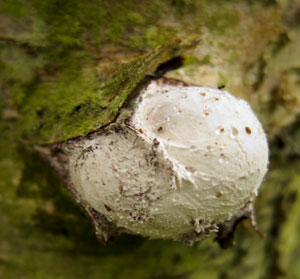Woodland carbon recycling

The world store of terrestrial carbon is estimated at 2860Pg (petagram = 1015 g), of this, some 1240 Pg is ‘locked up’ in woodlands – that is over 40%. Much of woodland carbon is ‘locked’ in dead leaves and decaying wood – in the form of complex organic molecules (carbohydrates, proteins, lignin, cellulose, pectates etc) that make up a plant.
However, with time these molecules can be degraded, broken down by the activities of micro-organisms (bacteria and fungi) – though the first stage of the process may be a physical disruption by beetles (saproxylic) and other burrowing small animals. The activity of fungi is more obvious / visible at this time of year (autumn) as their fruiting bodies (in the forms of mushrooms and toadstools) erupt from the soil, from dead trees and, indeed, living ones. Fungal forays are popular at this time of year – but beware : collecting fungi needs an expert eye as some are highly toxic.
The bulk of a fungus is never seen – it permeates the soil or a rotting trunk as a system of microscopic threads (hyphae). These hyphae are collectively termed the fungal mycelium. The mycelium grows and spreads, secreting enzymes which break down the complex carbon compounds in the soil, or dead leaves, or rotting wood. The large, insoluble carbon compounds are broken down into smaller, soluble ones that are absorbed by the hyphae – these simple sugars etc are then used in respiration and carbon dioxide is released.
The rate of this breakdown is in part dependent on temperature – so there is the question “If global temperature goes up, will the rate of this breakdown of stored carbon increase?” If the rate of breakdown increases, then more carbon dioxide will be released into the atmosphere, which in turn could increase global temperature further.
But it may be that if there is an increase in temperature that this will also affect the numbers of invertebrates – the woodlice, springtails, beetles etc. that live off / on and in this micro-habitat of the soil and decomposition layer (part of the detrital food chain).
 Initial experiments suggest that the numbers of these various ‘grazers’ changes with temperature, altering the type of fungi that dominate at different temperatures. Experiments are being undertaken by Donald A’Bear at Cardiff University and Tom Crowther (at Yale) – aimed at unraveling some of the complexities of the interactions between microbes, minibeasts and soil / woodland carbon.
Initial experiments suggest that the numbers of these various ‘grazers’ changes with temperature, altering the type of fungi that dominate at different temperatures. Experiments are being undertaken by Donald A’Bear at Cardiff University and Tom Crowther (at Yale) – aimed at unraveling some of the complexities of the interactions between microbes, minibeasts and soil / woodland carbon.
Further details of their work :
Comments are closed for this post.
